High Efficient CO2 Separation at High Pressure by Grain-Boundary-Controlled CHA Zeolite Membrane Investigated by Non-Equilibrium Molecular Dynamics
Abstract
1. Introduction
2. Calculation Method
3. Results and Discussion
3.1. Perfectly Crystalline Model
3.2. Polycrystalline Model
4. Conclusions
Author Contributions
Funding
Data Availability Statement
Conflicts of Interest
References
- Rubin, E.S.; Davison, J.E.; Herzog, H.J. The cost of CO2 capture and storage. Int. J. Greenh. Gas Control. 2015, 40, 378–400. [Google Scholar] [CrossRef]
- Baker, R.W.; Lokhandwala, K. Natural Gas Processing with Membranes: An Overview. Ind. Eng. Chem. Res. 2008, 47, 2109–2121. [Google Scholar] [CrossRef]
- Koros, W.J.; Mahajan, R. Pushing the limits on possibilities for large scale gas separation: which strategies? J. Membr. Sci. 2000, 175, 181–196. [Google Scholar] [CrossRef]
- Kong, X.; Qiu, H.; Meng, D.; Tang, X.; Yang, S.; Guo, W.; Zhang, Y.; Kong, L.; Zhang, Y.; Zhang, Z. Reproducible synthesis of all-silica CHA zeolite membranes in a homogeneous mother liquor. Sep. Purif. Tech. 2021, 274, 119104. [Google Scholar] [CrossRef]
- Wang, L.; Zhang, C.; Gao, X.; Peng, L.; Jiang, J.; Gu, X. Preparation of defect-free DDR zeolite membranes by eliminating template with ozone at low temperature. J. Membr. Sci. 2017, 539, 152–160. [Google Scholar] [CrossRef]
- Kida, K.; Maeta, Y.; Yogo, K. Preparation and gas permeation properties on pure silica CHA-type zeolite membranes. J. Membr. Sci. 2017, 522, 363–370. [Google Scholar] [CrossRef]
- Karakiliç, P.; Wang, X.; Kapteijn, F.; Nijmeijer, A.; Winnubst, L. Defect-free high-silica CHA zeolite membranes with high selectivity for light gas separation. J. Membr. Sci. 2019, 586, 34–43. [Google Scholar] [CrossRef]
- Araki, S.; Okubo, Y.; Maekawa, K.; Imasaka, S.; Yamamoto, H. Preparation of a high-silica chabazite-type zeolite membrane with high CO2 permeability using tetraethylammonium hydroxide. J. Membr. Sci. 2020, 613, 118480. [Google Scholar] [CrossRef]
- Kida, K.; Maeta, Y.; Yogo, K. Pure silica CHA-type zeolite membranes for dry and humidified CO2/CH4 mixtures separation. Sep. Purif. Tech. 2018, 197, 116–121. [Google Scholar] [CrossRef]
- Zhou, J.; Gao, F.; Sun, K.; Jin, X.; Zhang, Y.; L, B.; Zhou, R. Green Synthesis of Highly CO2-Selective CHA Zeolite Membranes in All-Silica and Fluoride-Free Solution for CO2/CH4 Separations. Energy Fuels 2020, 34, 11307–11314. [Google Scholar] [CrossRef]
- Xomeritakis, G.; Gouzinis, A.; Nair, S.; Okubo, T.; He, M.; Overney, R.M.; Tsapatsis, M. Growth, microstructure, and permeation properties of supported zeolite (MFI) films and membranes prepared by secondary growth. Chem. Eng. Sci. 1999, 54, 3521–3531. [Google Scholar] [CrossRef]
- Korelskiy, D.; Ye, P.; Nabavi, M.S.; Hedlund, J. Selective blocking of grain boundary defects in high-flux zeolite membranes by coking. J. Mater. Chem. A 2017, 5, 7295–7299. [Google Scholar] [CrossRef]
- Choi, J.; Jeong, H.; Snyder, M.A.; Stoenger, J.A.; Masel, R.I.; Tsapatisis, M. Grain Boundary Defect Elimination in a Zeolite Membrane by Rapid Thermal Processing. Science 2009, 325, 590–593. [Google Scholar] [CrossRef] [PubMed]
- Kim, J.; Jang, E.; Hong, S.; Kim, D.; Kim, E.; Ricther, H.; Simon, A.; Choi, N.; Korelskiy, D.; Fouladvand, S.; et al. Microstructural control of a SSZ-13 zeolite film via rapid thermal processing. J. Membr. Sci. 2019, 591, 117342. [Google Scholar] [CrossRef]
- Hong, S.; Kim, D.; Richter, H.; Moon, J.; Choi, N.; Nam, J.; Choi, J. Quantitative elucidation of the elusive role of defects in polycrystalline MFI zeolite membranes on xylene separation performance. J. Membr. Sci. 2019, 569, 91–103. [Google Scholar] [CrossRef]
- Park, S.; Lee, M.; Hong, S.; Jeong, Y.; Kim, D.; Choi, N.; Nam, J.; Baik, H.; Choi, J. Low-temperature ozone treatment for p-xylene perm-selective MFI type zeolite membranes: Unprecedented revelation of performance-negating cracks larger than 10 nm in polycrystalline membrane structures. J. Membr. Sci. 2023, 668, 121212. [Google Scholar] [CrossRef]
- Takaba, H.; Yamamoto, A.; Hayamizu, K.; Oumi, Y.; Sano, T.; Akiba, E.; Nakao, S. Dependence of the diffusion coefficients of methane in silicalite on diffusion distance as investigated by 1H PFG NMR. Chem. Phys. Lett. 2004, 393, 87–91. [Google Scholar] [CrossRef]
- Takaba, H.; Yamamoto, A.; Hayamizu, K.; Nakao, S. Gas Diffusion in Polycrystalline Silicalite Membranes Investigated by 1H Pulse Field-Gradient NMR. J. Phys. Chem. B 2005, 109, 13871–13876. [Google Scholar] [CrossRef] [PubMed]
- Arya, G.; Chang, H.; Maginn, E.J. Acritical comparison of equilibrium, non-equilibrium and boundary-driven molecular dynamics techniques for studying transport in microporous materials. J. Chem. Phys. 2001, 115, 8112–8124. [Google Scholar] [CrossRef]
- Yoshioka, T.; Tsuru, T.; Asaeda, M. Molecular dynamics studies on gas permeation properties through microporous silica membranes. Sep. Purif. Tech. 2001, 25, 441–449. [Google Scholar] [CrossRef]
- Hirosawa, F.; Miyagawa, M.; Takaba, H. Selectivity enhancement by the presence of grain boundary in chabazite zeolite membranes investigated by non-equilibrium molecular dynamics. J. Membr. Sci. 2021, 632, 119348. [Google Scholar] [CrossRef]
- Yoshioka, T.; Asaeda, M.; Tsuru, T. A molecular dynamics simulation of pressure-driven gas permeation in a micropore potential field on silica membranes. J. Membr. Sci. 2007, 293, 81–93. [Google Scholar] [CrossRef]
- Nagumo, R.; Takaba, H.; Nakao, S. A Methodology to Estimate Transport Diffusivities in ‘Single-File’ Permeation through Zeolite Membranes Using Molecular Simulations. J. Chem. Eng. Jpn. 2007, 40, 1045–1055. [Google Scholar] [CrossRef]
- Miyamoto, M.; Fujioka, Y.; Yogo, K. Pure silica CHA type zeolite for CO2 separation using pressure swing adsorption at high pressure. J. Mater. Chem. 2012, 22, 20186–20189. [Google Scholar] [CrossRef]
- Krishna, R.; van Baten, J.M. Insights into diffusion of gases in zeolites gained from molecular dynamics simulations. Micropor. Mesopor. Mater. 2008, 109, 91–108. [Google Scholar] [CrossRef]
- Krishna, R.; van Baten, J.M. Maxwell–Stefan modeling of slowing-down effects in mixed gas permeation across porous membranes. J. Membr. Sci. 2011, 383, 289–300. [Google Scholar] [CrossRef]
- Li, S.; Martinek, J.G.; Falconer, J.L.; Noble, R.D.; Gardner, T.Q. High-Pressure CO2/CH4 Separation Using SAPO-34 Membranes. Ind. Eng. Chem. Res. 2005, 44, 3220–3228. [Google Scholar] [CrossRef]
- Krishna, R.; van Baten, J.M. Using the spreading pressure to inter-relate the characteristics of unary, binary and ternary mixture permeation across microporous membranes. J. Membr. Sci. 2022, 643, 120049. [Google Scholar] [CrossRef]
- Takaba, H.; Yamamoto, A.; Nakao, S. Modeling of methane permeation through a defective region in MFI-type zeolite membranes. Desalination 2006, 192, 82–90. [Google Scholar] [CrossRef]
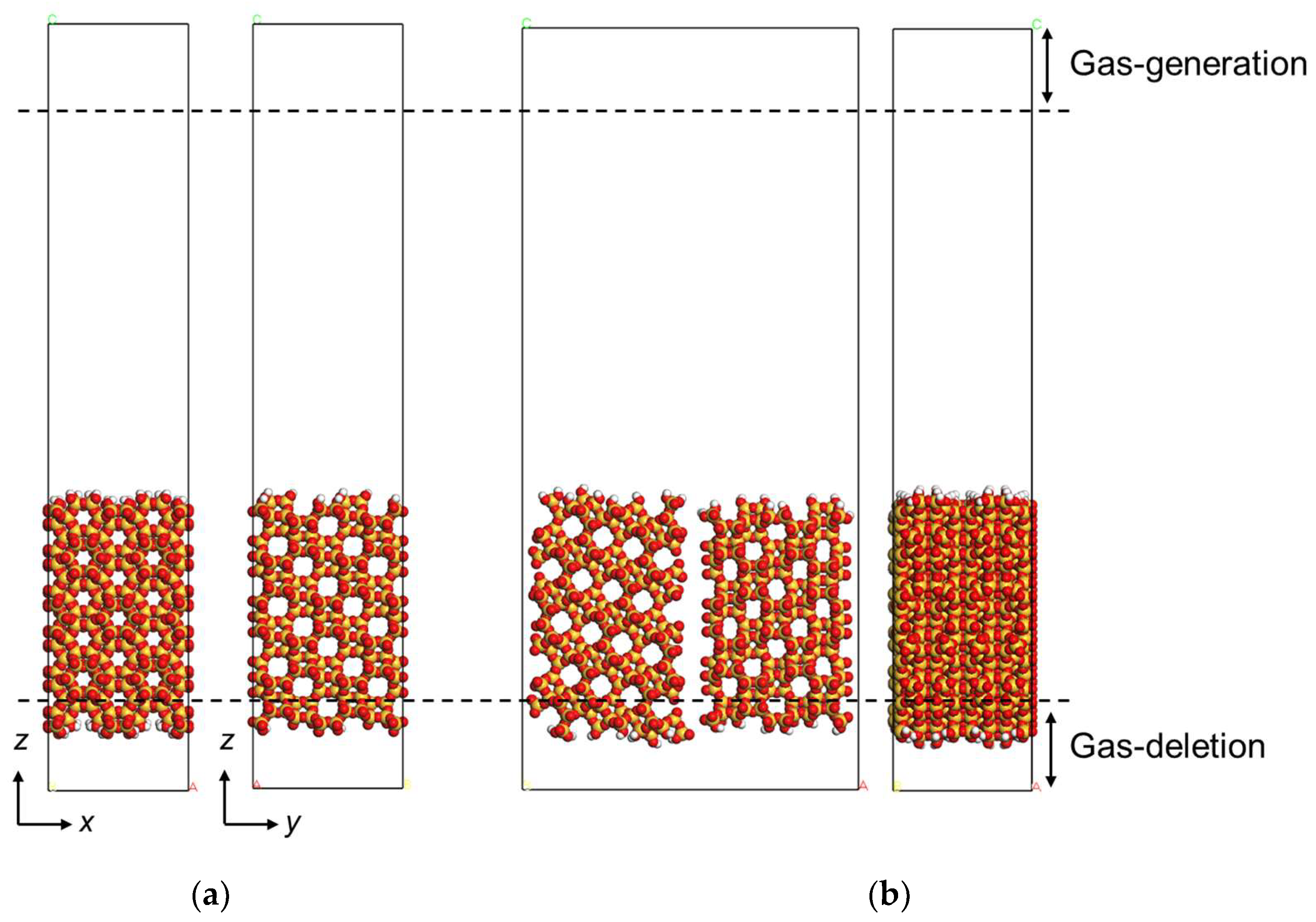
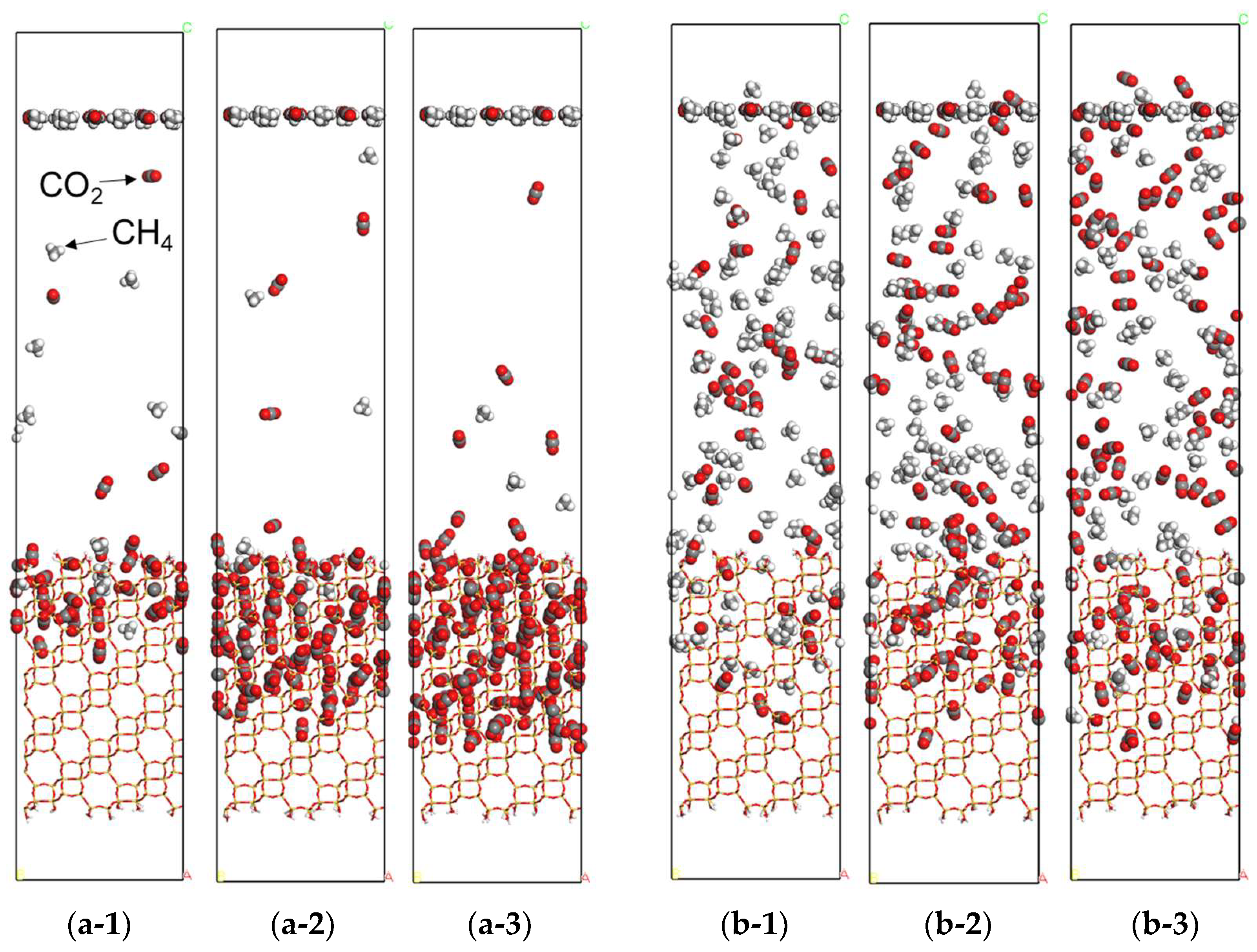

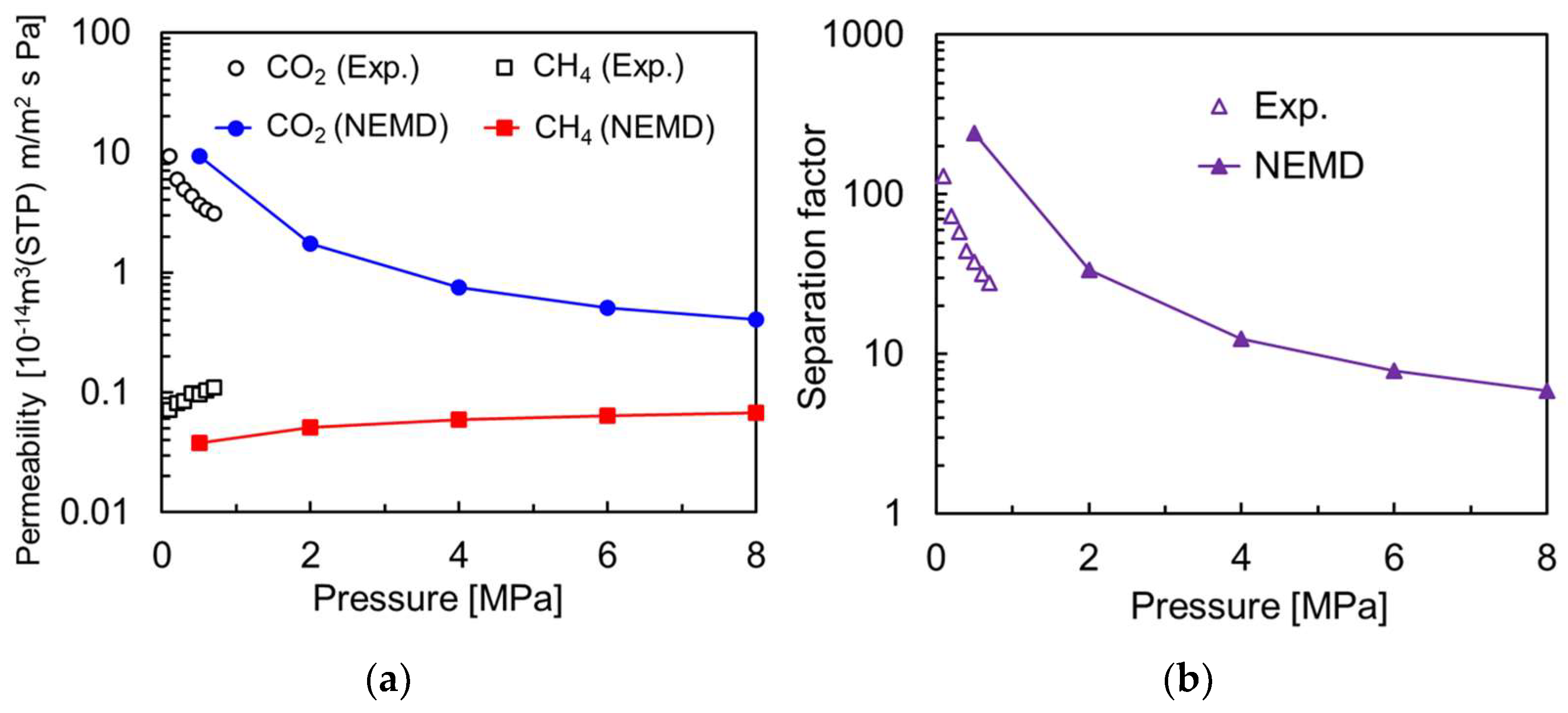
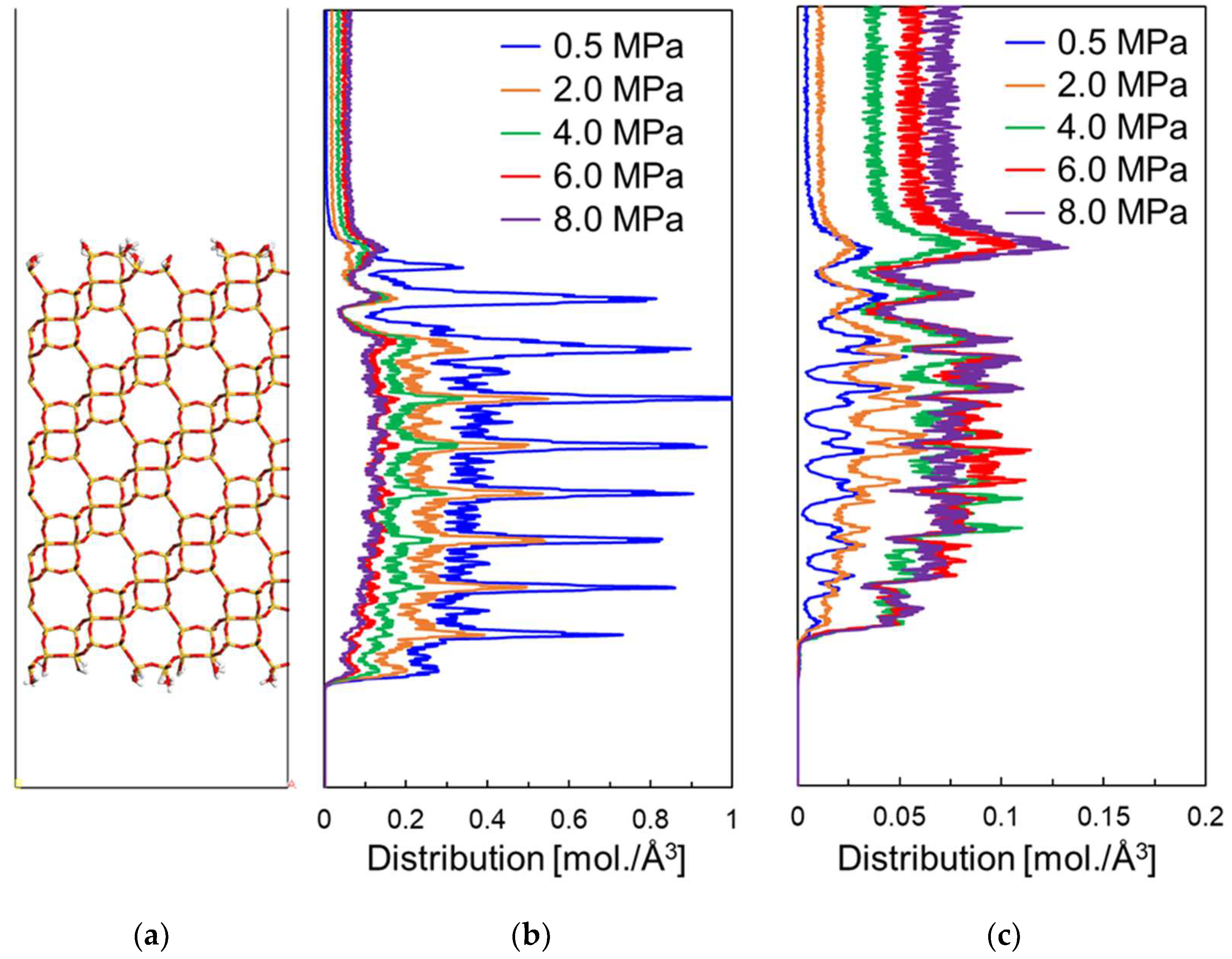
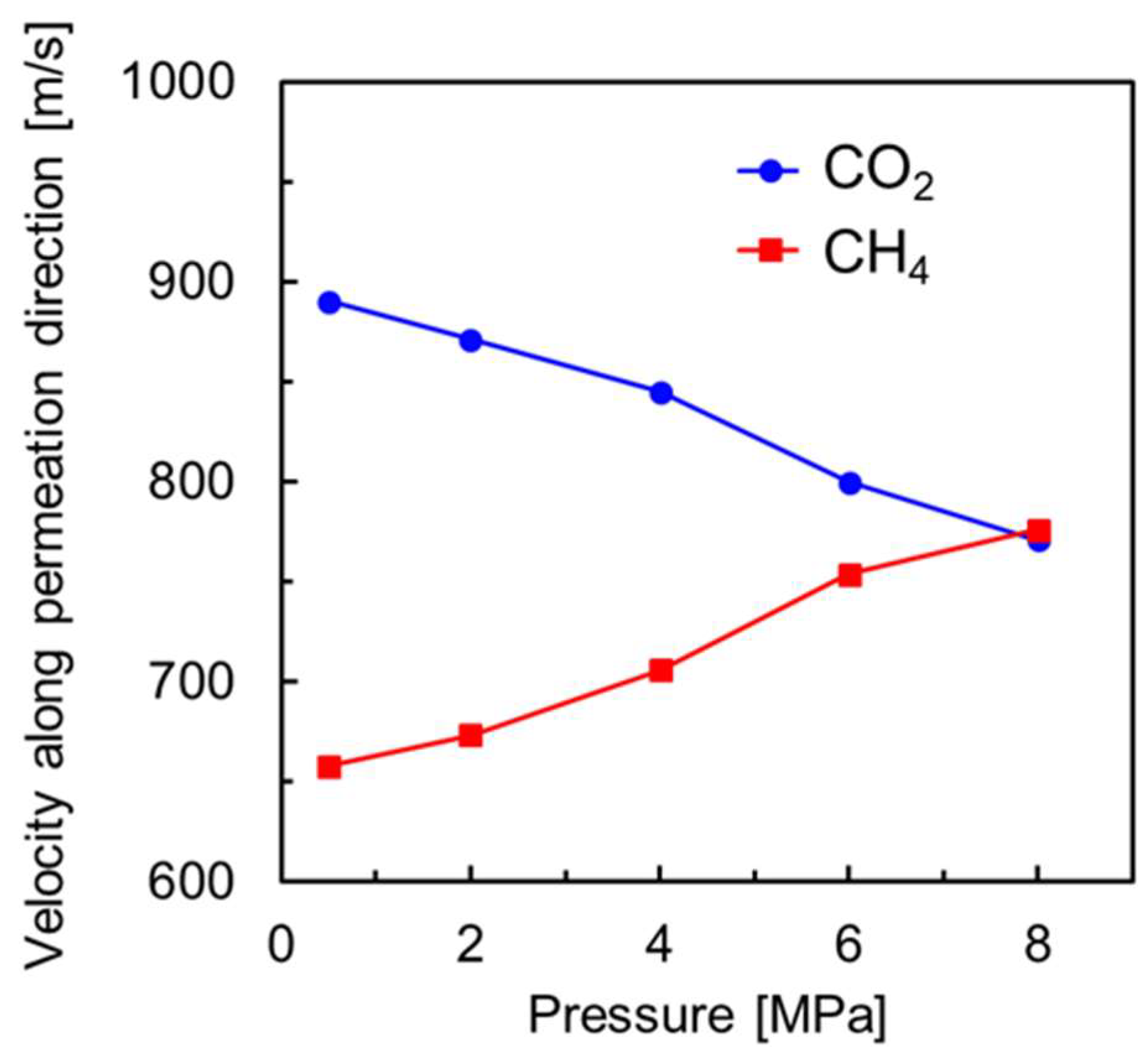
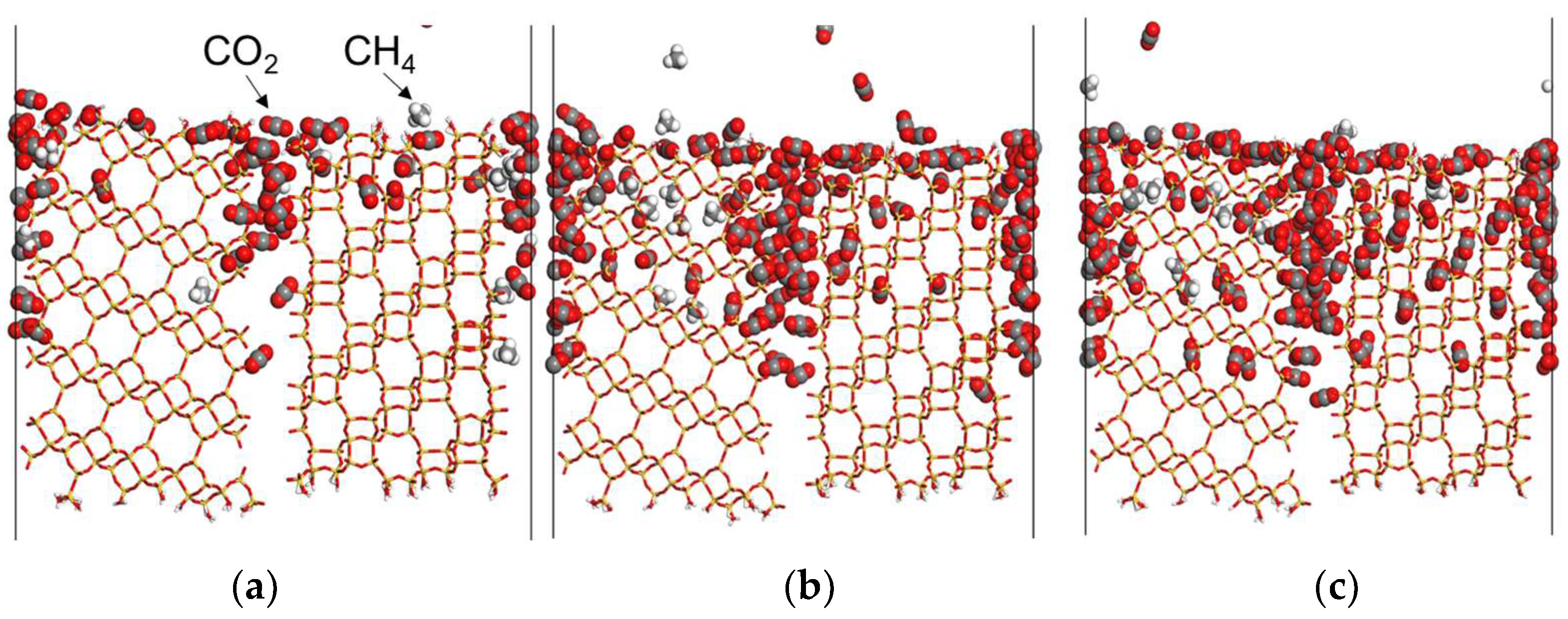

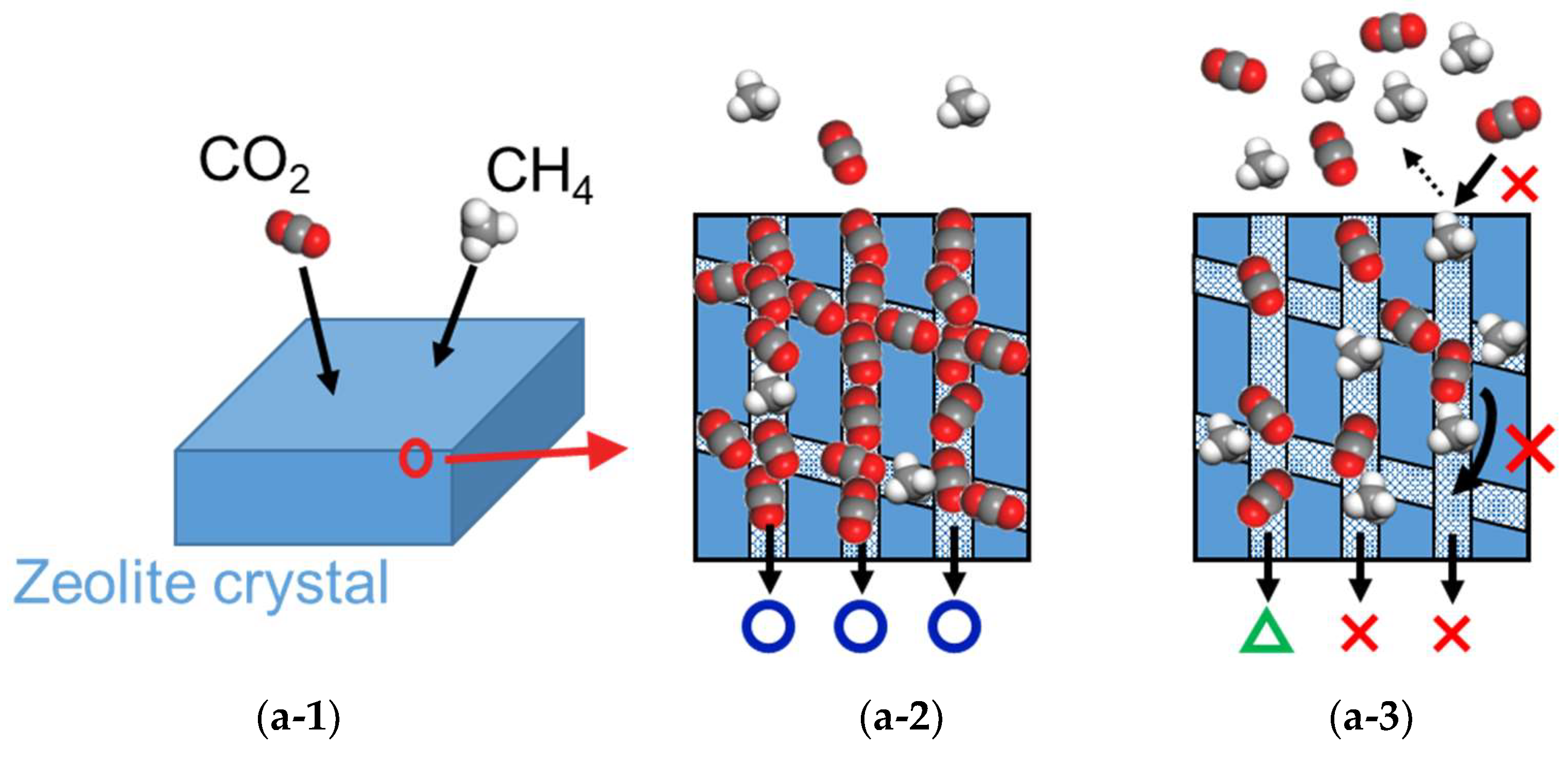

| f (fs) | ||||||
|---|---|---|---|---|---|---|
| 0.5 MPa | 2.0 MPa | 4.0 MPa | 6.0 MPa | 8.0 MPa | ||
| Perfectly crystalline | CO2 | 21,524 | 5381 | 2690 | 1794 | 1345 |
| CH4 | 12,978 | 3245 | 1622 | 1082 | 811 | |
| Polycrystalline | CO2 | 9146 | 2287 | 1143 | 762 | 572 |
| CH4 | 5515 | 1379 | 689 | 460 | 345 | |
Disclaimer/Publisher’s Note: The statements, opinions and data contained in all publications are solely those of the individual author(s) and contributor(s) and not of MDPI and/or the editor(s). MDPI and/or the editor(s) disclaim responsibility for any injury to people or property resulting from any ideas, methods, instructions or products referred to in the content. |
© 2023 by the authors. Licensee MDPI, Basel, Switzerland. This article is an open access article distributed under the terms and conditions of the Creative Commons Attribution (CC BY) license (https://creativecommons.org/licenses/by/4.0/).
Share and Cite
Hirosawa, F.; Miyagawa, M.; Takaba, H. High Efficient CO2 Separation at High Pressure by Grain-Boundary-Controlled CHA Zeolite Membrane Investigated by Non-Equilibrium Molecular Dynamics. Membranes 2023, 13, 278. https://doi.org/10.3390/membranes13030278
Hirosawa F, Miyagawa M, Takaba H. High Efficient CO2 Separation at High Pressure by Grain-Boundary-Controlled CHA Zeolite Membrane Investigated by Non-Equilibrium Molecular Dynamics. Membranes. 2023; 13(3):278. https://doi.org/10.3390/membranes13030278
Chicago/Turabian StyleHirosawa, Fumiya, Masaya Miyagawa, and Hiromitsu Takaba. 2023. "High Efficient CO2 Separation at High Pressure by Grain-Boundary-Controlled CHA Zeolite Membrane Investigated by Non-Equilibrium Molecular Dynamics" Membranes 13, no. 3: 278. https://doi.org/10.3390/membranes13030278
APA StyleHirosawa, F., Miyagawa, M., & Takaba, H. (2023). High Efficient CO2 Separation at High Pressure by Grain-Boundary-Controlled CHA Zeolite Membrane Investigated by Non-Equilibrium Molecular Dynamics. Membranes, 13(3), 278. https://doi.org/10.3390/membranes13030278







